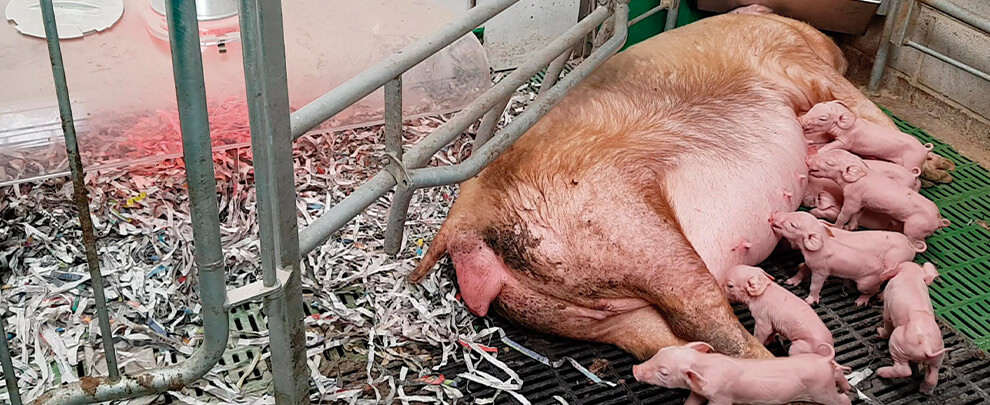Blog
Blog

Let’s talk about the use of cages in pig production in the EU
08th February 2022 - News
Óscar Toledano. Sales Manager & BI Rotecna.
In October 2020, a committee of citizens from several countries of the European Union presented to the European Commission, the institution that holds the executive power and the legislative initiative of the EU, a European Citizens' Initiative (ECI) after collecting 1,397,113 citizen signatures in the EU ‘s 28 countries, 85,756 of them in Spain.
The enterprise, called “End the cages age”, calls on the Commission to ban the use of cages for egg-laying hens, rabbits, pullets, broiler breeders, broodstocks, quails, ducks and geese, and sowing grounds and individual cages for sows and calves in countries where it is not already forbidden.
The European Parliament, at the plenary session June 2021, held a debate on this initiative and embraced a resolution recognising that alternative systems to cages are being successfully implemented in several Member States and that the request is aligned with the European Green Deal objectives to turn the European Union into a modern economy, efficient, sustainable and competitive, reflected in the “From farm to fork” strategy, which we already talked about in a previous article, and which also includes the promotion of the improvement of animal welfare.
The Commission, therefore, intends to propose the gradual elimination, and finally the prohibition, of the use of such cage systems, which with pork production will affect their use in the period between weaning and covering, the first four weeks of gestation and maternity, since 2013 the EU already prohibits the use of cages during the period between the following four weeks to the coverage and the seven days before the expected date of delivery.
The Commission has been asked to assess the impact of implementing these measures and present a governmental proposal by the end of 2023. The new regulation is expected to come into force in 2027 and provide for an immediate ban on new farms, with a phase-out period for existing ones, as has been done previously in implementing similar restrictions. These new limitations raise numerous doubts about how they can impact sows’ and piglets’ well-being, the different tasks and management procedures and, finally, the productive and economic results. When in 2001 a new animal welfare regulation was approved for the member states of the European Union, applicable to new farms from 2005 and to all existing ones from 2013, we were told that pregnant sows should be confined in groups from the fourth week after insemination until the week before calving. Many argued that the new law would lead to an increase in production costs, leading to a significant loss of competitiveness for EU pork producers but, after over 8 years of widespread use, it has been seen that this has not been the case; in fact, it has significantly increased productivity, which has lowered costs. How was it possible? Will the same happen with this new regulation?
"The new regulation is expected to come into force in 2027 and provide for an immediate ban on new farms."
First, we must remember, when the Commission considers new initiatives in animal welfare, it relies on independent scientific research, and also assesses any negative impacts, such as disease risks, animal welfare, worker safety, food safety, etc., based above all on the opinions of the European Food Safety Authority (EFSA), the Commission's chief scientific adviser in these areas. In addition, cage-free pig production systems are well known and applied successfully in different places for years, such as in Sweden since 1994 and in the United Kingdom since 1999, so we have the design and equipment knowledge to deal with them successfully, such as electronic individual group feeding without competition, automated group heat detection, free maternity places with temporary confinement cages, nest systems for piglets that maximise the time animals spend in it, etc.
With the design of appropriate facilities and animal management, these systems can increase the sows’ welfare and improve their physical fitness and health, which leads to a reduction in the need for antibiotics and an increase in productivity. As fertility increases, prolificacy is increased, calvings are shorter, piglets are better warmed, feed consumption and milk production increase, there need not be a significant increase in maternity leave, the weaning-covering interval is reduced, etc.
So, if we have the right guidance, we should not worry, although obviously, the interruption of the use of cages will require changes in current breeding systems and often expensive investments. Let us hope, therefore, that the EU will take this into account and subsidise farmers in this transition.
Finally, we must be aware that although a new challenge is always an opportunity to improve, unfortunately, one rarely grows without an external force that causes it. One tends to overvalue the position we are in because it makes us uncomfortable to leave our comfort zone, but that is the way to grow. One of the reasons why European pig farming has reached such high levels of productivity and sustainability is because of problems like labour shortages, lack of land, the high price of raw materials, high energy costs, high population concentration, consumer demand for very high standards of food safety, environmental, health, animal welfare, etc. All this has forced us to innovate and become pioneers, but it has also led us to be role models for anyone who wants to undertake a sustainable high-performance pork production model.






